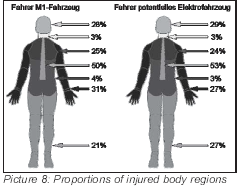EVU XXIII 2014-29 Analysis of potential accident scenarios of a future electrical city car on the basis of real accident data
Dr. L. Hannawald, H. Liers
 Institute of Traffic Accident Research at University of technology Dresden
Institute of Traffic Accident Research at University of technology Dresden
Abstract
The pollutant loads in German cities exceed the threshold given by the EC regularly. To prevent a region wide ban on vehicles, electrical drives become more and more attractive. This electrical drives are locally emission free and therefore a key technology for the urban mobility in the future.
The limited factor of these vehicles is the small energy density of the battery packs. To realize appropriated ranges of these cars it is necessary to reduce the weight of the cars to a minimum.
The UNECE has defined different vehicle classes, beneath special classes for micro cars. These classes have a higher scope at the regulations for vehicle and safety construction. Independent of that also these vehicles has to cover the state of the art of vehicle safety to reach a high level oh consumer acceptance.
These cars are currently rare on the roads. Therefore no reliable information regarding the traffic and accident scenarios with these cars is available. To predict the potential accident scenarios of these vehicles more than 22.000 real accident out of the GIDAS database (German In-Depth Accident Study were taken into account. Out of these accidents all cars and scenarios were extracted which represent the usage and vehicle characteristics of electrical cars as best as possible. After that, many accident parameters of these potential electrical vehicles were compared with conventional M1 vehicles. After weighting the data to the national statistic, representative statements can be given regarding the predicted accident scenario in Germany. With this predicted accident scenarios, estimates of the distributions of crash parameters (e.g. Delta V, EES) will be presented.
With that comparison, safety requirements for new electric vehicles could be derived. In addition to the analysis of typical crash constellations, collision partners and injury pattern, the relevance of current crash tests is estimated. Furthermore, estimations of the potential benefit of primary safety systems were done. Although the vehicle collective only consists of mini/micro/compact cars, the mass difference between the crash opponents is considerable. Therefore the mass differences in the predicted accident scenarios and the consequences to that are considered. The study estimates the potential accident scenarios of modern urban vehicles for the first time with a high number of real traffic accidents.
Testo completo della pubblicazione scientifica disponibile ai soli iscritti.
| Autore | Dr. L. Hannawald, H. Liers Institute of Traffic Accident Research at University of technology Dresden |
| Pubblicato il | |
| Tipologia |
